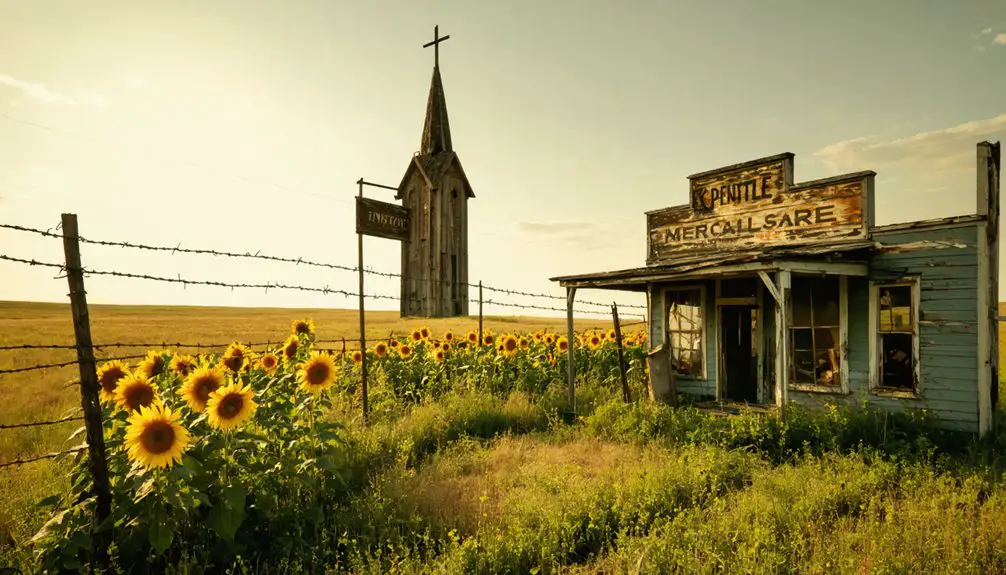You’ll find Hawkeye’s remnants among Kansas’s most intriguing ghost towns, where Russian Mennonite settlers once transformed the prairie landscape in the 1870s. The community thrived through agriculture and mining until 1934, when the government mysteriously purchased over 1,000 acres, leading to its abandonment. Today, the site holds tales of unexplained phenomena, ghostly encounters near abandoned buildings, and fascinating connections to frontier conflicts. The truth behind Hawkeye’s sudden decline lies deeper than its visible ruins suggest.
Key Takeaways
- Hawkeye was established as a prairie settlement in Kansas with basic amenities like a general store and post office.
- The government’s purchase of over 1,000 acres in 1934 marked a turning point, leading to significant population decline.
- Economic changes, including decreased mining operations and farming mechanization, contributed to the town’s eventual abandonment.
- Mennonite settlers significantly influenced the area in the 1870s before its decline, introducing revolutionary winter wheat farming techniques.
- The ghost town now features abandoned buildings with reported supernatural occurrences, inspiring local folklore and ghost stories.
The Rise and Fall of a Prairie Settlement
While the exact founding date remains unclear, Hawkeye emerged as a prairie settlement in Kansas during the late 19th or early 20th century, establishing itself as a small but vibrant agricultural community.
You’d have found essential amenities like a general store and post office serving the area’s farming families. Similar to nearby towns like Milan, Hawkeye once had a small grocery store. The population dynamics followed a familiar pattern – the town peaked in the early 1900s when rural Kansas settlements thrived.
But economic shifts proved challenging. As agricultural technology advanced, fewer workers were needed on farms. The lack of significant railroad connections and competition from larger towns gradually drew commerce away. The area underwent a major transformation when the government purchased land in 1934, acquiring over a thousand acres of grassland near the settlement.
Government Land Acquisition Mystery
You’ll find that after the Louisiana Purchase of 1803, the government’s acquisition strategies in Hawkeye followed unusual patterns that weren’t typical of other Kansas settlements. While most towns saw straightforward land claims through proper documentation and gubernatorial approval, Hawkeye’s property transfers left behind puzzling gaps in official records.
Unlike standard Kansas settlements, Hawkeye’s post-Louisiana Purchase land transfers defied normal patterns, leaving mysterious gaps in government documentation.
You might wonder why the government’s involvement in Hawkeye’s land transactions remains so obscure. Unlike neighboring communities where ownership chains are clearly documented, you’ll discover that Hawkeye’s records suggest possible undisclosed government interests. The first official land ownership in the region came through the Louisiana Purchase when France sold the territory that would become Kansas to the United States. Like many Kansas settlements, Hawkeye eventually succumbed to economic depression, leading to decreased commercial activity and population decline.
These mysterious acquisitions, combined with rapid population exodus, have led many to question whether strategic government buyouts, rather than typical economic decline, sealed Hawkeye’s fate.
Underground Discoveries and Secret Operations
Beneath Hawkeye’s weathered surface lies a network of shallow tunnels and mining remnants that tell a fascinating story of 1850s mineral exploration.
You’ll find evidence of small-scale gold panning operations, marked by scattered hand-dug pits and alluvial gravel beds that early settlers once worked in secret.
During the Cold War, you might’ve encountered classified government activities near these abandoned tunnels, though official records remain sparse.
Like Iowa Point’s population, the town reached over 3,000 residents during the 1850s before its eventual decline and abandonment.
Similar to how post office operations ceased in Columbia, local mail services were redirected to larger towns.
Local speculation suggests covert operations may have utilized the ghost town’s existing underground network, possibly for military training or communications relay stations.
Today, you can discover well-preserved underground artifacts from both settlers and Native Americans near the town’s natural springs, including trading goods and domestic implements that reveal daily life before Hawkeye’s mysterious abandonment.
These finds continue to attract archaeological interest and fuel debates about the site’s true history.
Local Mennonite Community Impact
During the 1870s, you’d find Russian, Polish, and Prussian Mennonites transforming the landscape around Hawkeye through their strategic settlements and agricultural expertise.
With over $2.25 million in gold, they purchased vast tracts of land, establishing tight-knit farming communities that would shape the region’s future.
Pooling their resources of $2.25 million in gold, Mennonite settlers created prosperous agricultural communities that transformed the region permanently.
You’ll notice how Mennonite traditions influenced local society through their commitment to nonviolence, adult baptism, and strong communal ties.
Their cooperative farming methods and economic success drew both skepticism and admiration from neighboring towns.
They introduced hard winter wheat cultivation techniques that revolutionized Kansas farming.
This migration was part of a larger movement that brought 18,000 Mennonites to the Great Plains seeking religious freedom and farmland.
Agricultural Legacy and Regional Changes
As agricultural technology swept through the Plains region in the mid-20th century, you’d find Hawkeye’s landscape transforming from a patchwork of small family farms into vast, mechanized operations. Similar to railroad expansion that shaped towns like Bushong in the 1870s, these changes fundamentally altered rural communities.
Agricultural consolidation reshaped the community as fewer farmers managed larger tracts of land. Rural depopulation followed when farm families couldn’t sustain their traditional way of life. Like many communities during the Great Depression, Hawkeye witnessed families abandoning their farms and livelihoods.
- New hybrid seeds and irrigation systems doubled crop yields
- Modern machinery replaced the need for manual labor
- Young people left for urban opportunities, leaving aging farmers behind
- Essential businesses closed as the population dwindled
- The 1934 federal land purchase of over 1,000 acres near Hawkeye marked a turning point
You’ll recognize this pattern across Kansas, where technological progress inadvertently hastened the decline of tight-knit farming communities like Hawkeye.
Historical Significance in Kansas Ghost Towns
While many Kansas ghost towns faded into obscurity, Hawkeye shares a common historical trajectory with places like Lecompton, where political and economic forces shaped their destinies.
You’ll find that towns like Hawkeye reflected the broader patterns of political significance in territorial Kansas, where the struggle between free-state and pro-slavery interests determined settlement outcomes.
The transportation evolution proved essential to Hawkeye’s fate, much like other ghost towns across the state.
When railroads bypassed certain communities or shifted their routes, they’d effectively seal a town’s destiny.
You can trace Hawkeye’s decline through the familiar pattern seen in places like Vinland and Trading Post, where changing economic foundations and transportation networks left once-thriving communities to wither as residents sought opportunities elsewhere.
Legends and Literary Connections

Beyond its physical remains, Hawkeye’s legacy lives on through rich folklore and literary traditions that capture the imagination of Kansas history enthusiasts.
You’ll find tales of ghostly encounters woven into the fabric of local storytelling, from mysterious lights dancing across abandoned buildings to whispered accounts of mining accidents and frontier conflicts.
These folklore adaptations have inspired numerous writers who’ve used Hawkeye’s haunting atmosphere in their Western narratives.
- Experience spine-tingling tales of outlaw hideouts and legendary shootouts
- Discover stories of Civil War guerrillas and their hidden treasures
- Explore documented sightings of unexplained phenomena at nightfall
- Learn about mining disasters that shaped local supernatural lore
- Witness how modern documentarians keep these frontier stories alive
Frequently Asked Questions
Are There Any Remaining Buildings or Structures Still Standing in Hawkeye Today?
You won’t find conclusive evidence of remaining structures in this location today. While the site holds historical significance, available records don’t document any verified standing buildings or ruins currently present.
What Was the Peak Population of Hawkeye Before It Became Abandoned?
Like many Kansas ghost towns that experienced rapid population decline, you won’t find reliable peak population data for Hawkeye. Historical significance is difficult to verify without documented records from this settlement.
Did Any Famous Historical Figures Ever Visit or Live in Hawkeye?
You won’t find any famous visitors or historical connections to nationally known figures in Hawkeye’s past. The town’s secretive government activity in the 1930s involved local Mennonites rather than celebrities.
Were There Any Documented Paranormal Activities or Ghost Sightings in Hawkeye?
You won’t find any verified ghost encounters or spectral evidence in official records. Despite some local legends about government activities in the 1930s, there’s no confirmed paranormal activity from this location.
What Natural Disasters or Extreme Weather Events Affected Hawkeye’s History?
Like a relentless siege, you’d have faced tornado impacts ravaging farmsteads, while prolonged droughts during the 1930s Dust Bowl devastated crops. Flash floods and brutal blizzards further isolated this Kansas plains community.
References
- https://www.wikiwand.com/en/map/Hawkeye
- https://michael-hankins.com/2023/05/23/hawkeye-kansas/
- https://www.hhhistory.com/2019/05/ghost-towns-of-kansas.html
- https://www.youtube.com/watch?v=alC1wDdSVvg
- https://legendsofkansas.com/kansas-ghost-town-list/
- https://www.youtube.com/watch?v=OyBXD18P_j4
- https://kids.kiddle.co/List_of_ghost_towns_in_Kansas
- https://en.wikipedia.org/wiki/Osborne_County
- https://www.realtor.com/news/real-estate-summary/kansas-ghost-towns-recap/
- https://www.youtube.com/watch?v=nOOEY5ClP7Q



